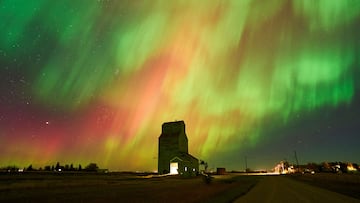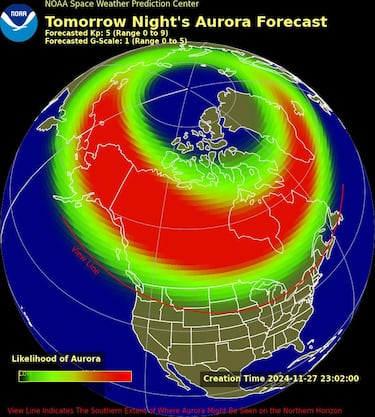Northern Lights to bring treat on Thanksgiving and Black Friday: When and where you can see the aurora borealis
Those in the northern part of the US will have something to be grateful for on Thanksgiving, the sky is expected to be lit up by the aurora borealis.

There will be more than one dazzling parade this year for Thanksgiving. While Macy’s in New York will get the day going with the department store’s iconic display of floats, giant balloons and stars, when the sun goes down the second will give stargazers another colorful display.
The National Oceanic and Atmospheric Administration (NOAA) is forecasting a solar storm to create a stunning spectacle when it interacts with our atmosphere producing the Northern Lights. They will be visible across large sections of the United States
Northern Lights to bring treat on Thanksgiving and Black Friday: When and where you can see the aurora borealis
Starting November 28, Thanksgiving Day, the aurora borealis will be visible from dusk till dawn on Black Friday, November 29. The geomagnetic storm will begin as a minor event (G1) on Thursday evening building to a moderate event (G2) in the early hours of Friday.
All of Alaska is forecast to have the Northern Lights dancing in the sky according to the NOAA prediction. The best views in the lower 48 will be for those in the North Central Plains from Montana over to the Great Lakes.
However, those within an arc from Puget Sound over to southern Wisconsin then circling up to northern Maine should be within NOAA’s forecast viewline for the aurora. Below you can see in detail where the aurora will be the most intense and visible.

What causes the Aurora Borealis?
The Northern Lights are produced when highly charged particles from the Sun get funneled by the Earth’s magnetic field and they fall into the atmosphere at high speed. Then those particles interact with the upper atmosphere, at altitudes of 60 to more than 250 miles up, and the resulting ionization of the atmosphere creates the colorful dance of light across the sky. They can glow in a variety of colors, including vivid greens and purples.
The Northern Lights are most commonly seen in the polar regions with the best viewing anywhere with a magnetic latitude above 55º and low light pollution. You can find your magnetic latitude either at NOAA or World Data Center for Geomagnetism.
However with strong solar flares the lights can be seen at lower latitudes than normal. For a reference Minneapolis is at 55º magnetic latitude and about 300 miles from the Canadian border but Seattle less than half the distance is at less than 53º. The storm on October 10 and 11, 2024 was a Level 4 event, out of 5, during which there were sightings of the Aurora Borealis as far south as Mexico, Florida and even the Bahamas reported EarthSky.
If you're seeing the Northern Lights tonight, here's an explainer of how the different colors can appear! We are currently seeing a vivid display of pinks and greens here at the office! pic.twitter.com/S0NLzG5HOa
— NWS Northern Indiana (@NWSIWX) October 11, 2024
How can I see the Northern Lights?
The Northern Lights can occur anytime of the year but the darker it is the better. The best time to view the Aurora Borealis is during the equinoxes in March and September. They don’t usually exhibit for long coming and going a few minutes at a time. A good display may last for no longer than 15-30 minutes at a time, although if you’re really lucky, it could extend to a couple of hours or longer.
To see them the sky needs to be dark and clear of any clouds. They may appear like illuminated rain on the horizon depending on your latitude but the further north, or south depending on the hemisphere, you go the better chance they will fill the sky. National Geographic gives 7 of the best locations to view them.
How can I know when the Northern Light will appear?
There is no 100% guarantee of spotting the Northern Lights just hope that you are in the right place at the right time. There are forecasts available with the Kp Index is generally considered the most accurate. The forecast corresponds to the planetary magnetic index on a scale of one to nine, with one being very low activity and nine very high. The Geophysical Institute at the University of Alaska has an excellent website, which allows you to view predicted activity in all auroral regions. You can also sign up for Northern Lights forecast email alerts that tell you when activity rises above four to five on the Kp scale.
Get your game on! Whether you’re into NFL touchdowns, NBA buzzer-beaters, world-class soccer goals, or MLB home runs, our app has it all. Dive into live coverage, expert insights, breaking news, exclusive videos, and more – plus, stay updated on the latest in current affairs and entertainment. Download now for all-access coverage, right at your fingertips – anytime, anywhere.
